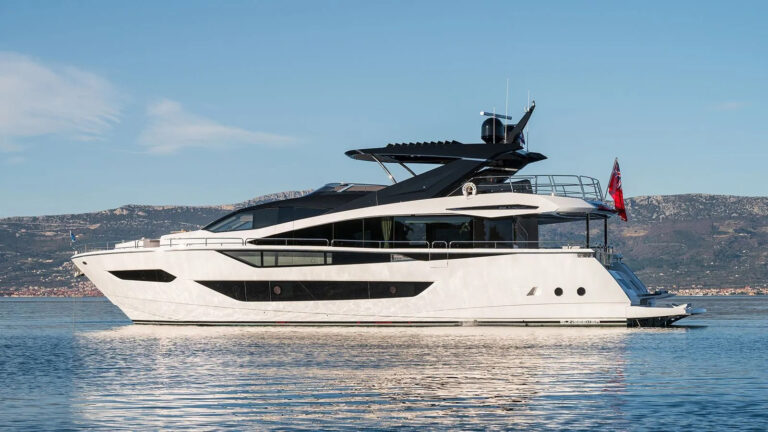Larger sportfishing boats, out of necessity, have always carried their tenders forward or not carried one at all. It simply won’t do to have anything in the way of the fishing end of the boat.
Now, motoryacht owners are catching on to the advantages of bow tender stowage. The primary benefit is freeing up space aft, whether for machinery, crew working areas or extra belowdecks accommodations, or for open deck areas, bigger saloons or lounges topside. Bow tender stowage also enhances safety by moving launch and retrieval operations away from guest areas.
If the yacht is large enough, a tender garage can be incorporated into the overall design by raising the forward trunk to the lower edge of the windows on the housefront. Not only does this protect the tender from sun and spray, it can improve the overall aesthetics of the yacht by breaking up the mass of the housefront and reducing its apparent height.
Flexibility in dining arrangements can make life aboard much more enjoyable, for guests and for crew. Superyachts often have a dining room for formal events and a country kitchen-style galley for casual eating and conversation. Most yachts, though, don’t have that kind of room to spare.
One option for these yachts is a divider that can be closed for formality or opened when the occasion is more relaxed. Smaller yachts often use a galley counter, sometimes doubling as a bar, with sliding panels or tambour doors above the countertop. Larger yachts can include pocket doors or rotating wall sections as dividers.
Taking a cue from these yachts, some superyachts are now incorporating large windows in galley bulkheads or providing seating within the galley itself. As the boats travel the world, celebrity chefs from each region are invited aboard to perform their art in full view of delighted guests.
Something as mundane as a shower drain usually gets little consideration from yacht designers, but that’s not always the case. While aboard a 325-foot yacht built in Holland for the Saudi royal family, I noticed that a drain did not interrupt the custom mosaic tile scene in the base of the shower. Looking a bit closer, I found that the shower incorporated a peripheral drain, allowing the water to run off all four sides of the base. Recently, several builders of smaller yachts-custom and production-have begun using this drainage system.
Not only does a peripheral drain open up all sorts of aesthetic possibilities, it has definite practical advantages. With a drain all around the floor pan, water never stagnates in the shower, regardless of trim or heel angles. In addition, guest comfort is improved, as the floor of the shower can be perfectly flat, with no need to slope it toward a single-point drain.
Convenience and privacy are the priorities of the night. Once I’ve said goodnight to my shipmates and settled into my cabin for the evening, I don’t want to come out until morning. In fact, on one superyacht, I couldn’t come out, as the alarm system protecting the owner’s onboard collection of Old Masters art alerted the crew anytime someone set foot in the passageway or saloon.
The solution is a self-contained stateroom, whether your yacht carries one or six. An en suite head is nice, of course. A TV opposite the berth is good, too, especially if it’s integrated with a central movie library. The best complement to that is one of the easiest amenities to add: a mini-fridge stocked with an assortment of drinks and light snacks. Built into the cabin’s joinery, it is close at hand without intruding.
There’s nothing like fresh-caught dolphin (no, not Flipper) prepared on a barbecue grill with a dash of lime and cayenne pepper and consumed alfresco while sitting around the flying bridge dinette. That handy little cooker can be a real hazard, though, if it’s not properly wired, and for my money, that includes an electrical switch interlocked with the grill’s lid.
On too many installations I’ve seen, it is possible to close the wood or fiberglass lid while the burner is on, with a fire as the result. It is relatively simple for an electrician to install a second switch that’s wired in series with the burner switch. Closing it activates the switch, which either turns off the burner, triggers an audible alarm or both. It’ll save the party, and maybe the yacht, too.
Enjoyment of a yacht increases in direct proportion to time spent under way. Whether it’s a full-fledged machine shop or a small workbench and toolbox mounted atop a generator box in the engineroom, facilities for mechanical maintenance and repair are a great idea for any motoryacht.
In addition to routine tasks such as changing oil and cleaning strainers, there will be the unplanned but inevitable moments when a repair becomes necessary. A minor mishap can keep you in port on a beautiful weekend if you have no way of effecting repairs. Even a breakdown at sea, while best avoided by regular preventive maintenance, can often be mitigated from catastrophe to mere nuisance if the necessary tools and equipment are at hand.
Mounds and Almond Joy got it right: Sometimes you feel like a nut, sometimes you don’t. The corollary aboard is the main deck pilothouse: Sometimes you want it open, sometimes you don’t.
Particularly on owner-operated yachts, the helmsman doesn’t want to be separated from the rest of the party, but isolation of the pilothouse is desirable for running at night. The easiest compromise is a simple door in an otherwise solid bulkhead, but that doesn’t lend much of an open feeling to the pilothouse. A better design has a more open bulkhead with retractable panels, curtains or blinds to give privacy to the pilothouse and saloon when needed.
It is said a collision at sea can ruin your entire day, but a fire at sea is worse. A proper fire extinguishing system can reduce insurance premiums and reduce damage to your yacht in the event of a fire. More to the point, it is invaluable protection for the lives of your family, guests and crew.
As critical as the components of the fire system itself are, of equal importance are the interfaces to other parts of the yacht. Before the extinguishing agent (whether carbon dioxide, Halon or another substance) is discharged, interlocked switches should shut down all engines and fans within the protected space, and flaps or dampers should close off ventilation ducts. Anything short of this risks the fire not being doused, or reflashing after initially being extinguished.
No matter how large a yacht is, there never seems to be enough room for everything. Spiral staircases are common on everything from family weekenders to custom superyachts because they save space and can be fitted into and around complicated cabin arrangements. Unfortunately, they are often poorly designed and difficult to navigate. The problem is treads that start out with adequate width around the outside but then taper to a point near the center. A better solution is a winding stair that is similar to a spiral and takes only a little more room.
The difference in dimension is just a few inches of width on the narrow end of each stair tread where it meets the bulkhead, but the improvement in comfort and safety is immense. Older and mobility-impaired guests will love it, and even the younger guests will find that carrying luggage or other loads from deck to deck is easier.
It doesn’t happen often, but I’ve seen the aftermath of a V-drive jackshaft that came loose at one end and swung around the back of a large diesel engine at 2000 rpm. Fortunately, no one was in the yacht’s engineroom at the time, for the devastation was incredible. One significant casualty was the main seacock, which led to major flooding of the engineroom.
In addition to a cover for the jackshaft and joints to protect personnel from contact injury, every V-drive installation should have a structural hoop or shroud that will contain the shaft in the event of a joint or coupling failure. The shroud should be bolted or welded to major structural members, such as the engine beds, and should incorporate a split hoop so the jackshaft can be more easily removed for service when necessary.









